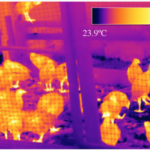Study: Aggressive Interactions Induce Rapid Temperature Changes in Pheasants
Researchers from University of Plymouth and University of Exeter conducted a study where they tracked thermographic changes in captive juvenile pheasant flocks as they had spontaneous aggressive interactions during a short confinement time frame. The researchers used thermal cameras to observe the young pheasants and their temperature changes during aggressive interactions which put in place the pecking order.
The study had 126 6-7 week-old pheasants that were reared at a research farm. The pheasants were a mix of unrelated pheasants, half siblings, and full siblings. The researchers documented aggressive dominance behavior acts, which naturally happened in groups of captive-reared young pheasants, and detailed infrared thermographic measurements of the temperature of their heads.
It was found that in brief seconds before an attack their head temperature greatly decreased after which it rose and then gradually diminished to baseline levels. On average, the temperature of the aggressors was higher than that of the recipients, however, the temperature changes were similar for both.
Learn about our two Decals!
 Click here to find out more about our Fall Bioinspired Design Decal and our Spring Bioinspired Design in Action Decal – ALL MAJORS are welcome.
Click here to find out more about our Fall Bioinspired Design Decal and our Spring Bioinspired Design in Action Decal – ALL MAJORS are welcome.Berkeley BioDesign Community
 Click here to learn about the BioD: Bio-Inspired Design @ Berkeley student organization or here to signup for more info.
Click here to learn about the BioD: Bio-Inspired Design @ Berkeley student organization or here to signup for more info.Search
Student Login




I imagine that the neurological circuits underlying these processes are governed by both 2d spacing maps with their brains as…
to reduce the impact of car accidents, it may be possible to study the force diverting physics of cockroaches to…
you see this type of head-bobbing stability in many avian creatures related to pigeons like chickens. the head ability to…
not like they taught horses how to run! this is an example of convergent evolution where both sea creatures and…
The brain functions in a similar way with neuronal connections. our brains are able to utilize the multiplicity of connections…